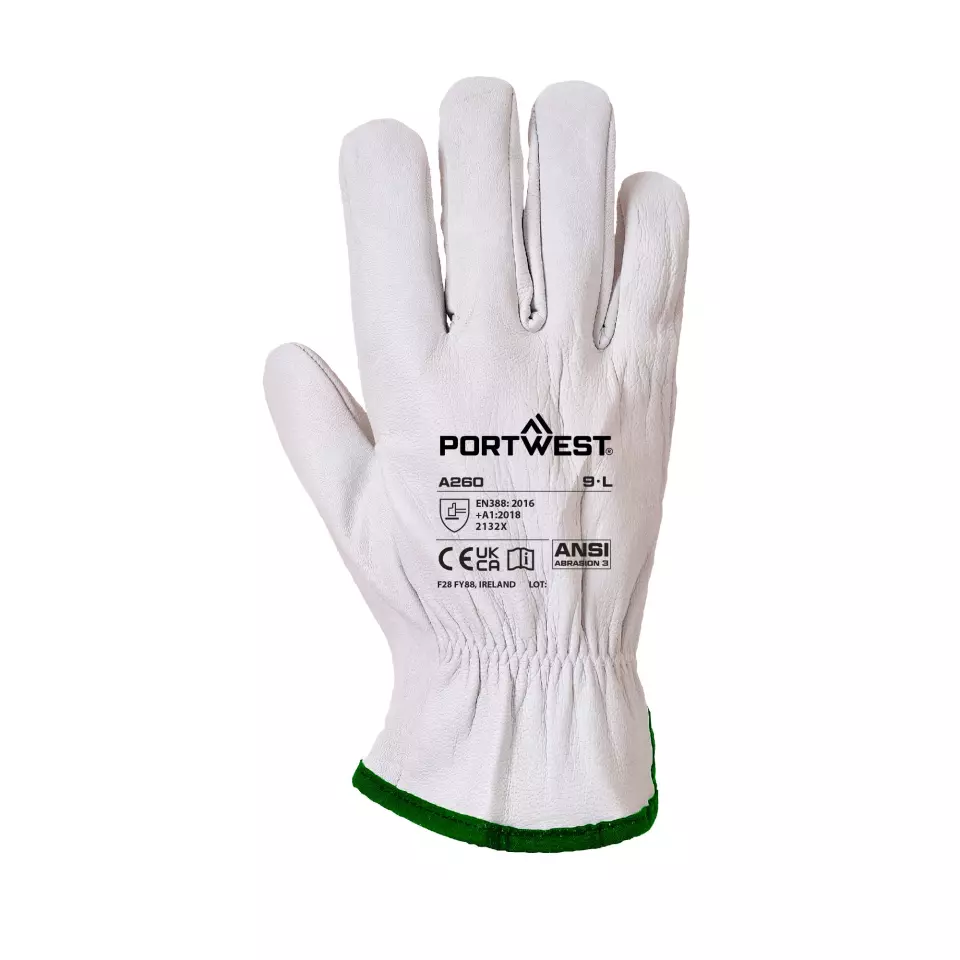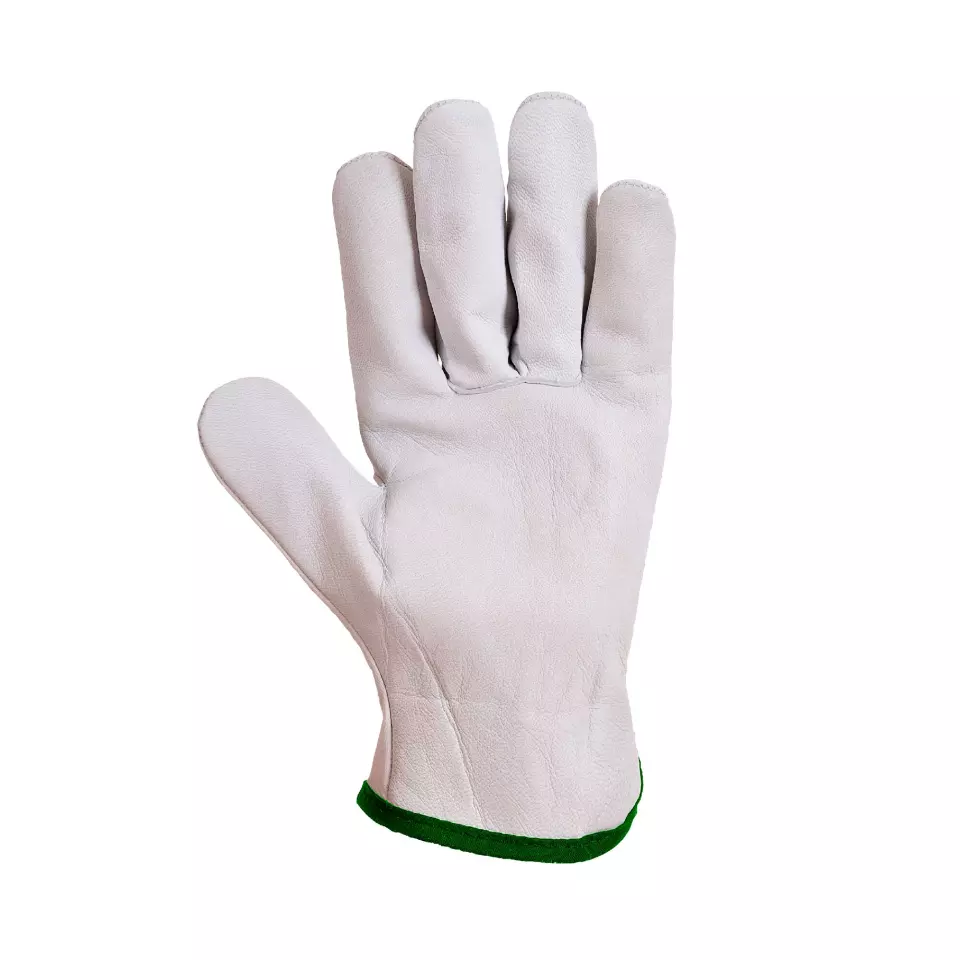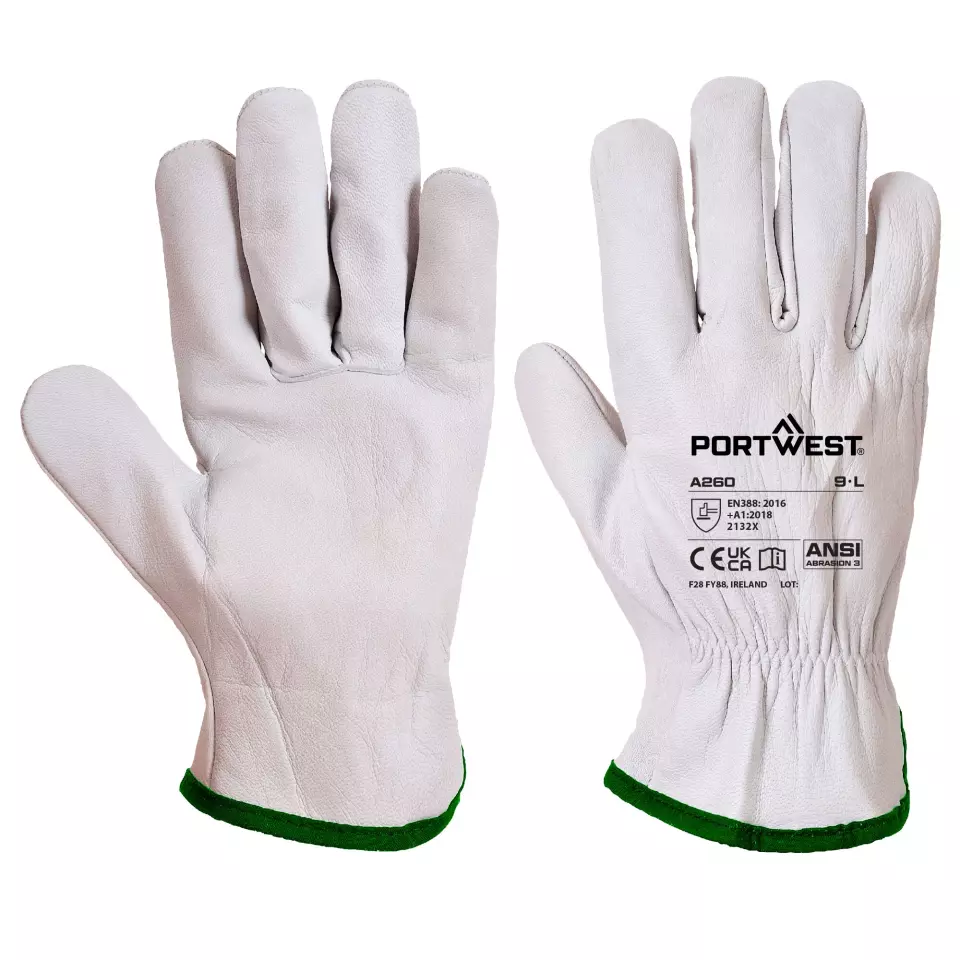Portwest Oves Driver Glove, Grey
Portwest
visit storeProduct description
These breathable leather work gloves are designed for use in mild and hot climates, preventing hands from overheating while maintaining durability and protection. The goat grain leather construction with elasticated cuffs provides a secure fit and enhanced dexterity. Meeting multiple safety standards including ANSI abrasion level 3 and EN 388 certification, these classic driver gloves offer reliable hand protection for various work applications.
Product Features:
- Breathable leather construction for mild and hot climate use
- Elasticated cuffs for secure fit
- Classic leather driver design
- Leather palm for improved durability
- Durable leather construction
Technical Details:
- Goat grain leather material
- ANSI abrasion level 3
- CE certified
- Certification: 2777/24121-01/E00-00 by SATRA Technology Europe Ltd
Standards:
- EN ISO 21420: 2020 Dexterity 5
- EN 388: 2016 + A1: 2018 (2132X)
- ANSI/ISEA 105: 2016 ABRASION Level (3)
Driver style gloves offer comfortable grip and superior dexterity for enhanced control.
Full finger coverage offers complete protection and warmth, keeping your hands safe and comfortable.
The material used on the palm side of the glove, affecting grip, durability, protection level, and comfort during use.
Determines how the glove secures around the wrist, affecting fit, protection from debris, and ease of putting gloves on and taking them off.
Determines visibility, safety compliance, and how well dirt and wear are concealed during use in different work environments.
- Cut Resistant
- Hand Protection
Request a free sample
Test first and buy later. Visit any product page to request your free sample.
Standards and labels
EN ISO 21420:2020 is a European standard that sets out the general requirements for hand protection, including comfort, fit, and dexterity.
EN 388:2016 is a European standard for measuring the performance of protective gloves against mechanical risks (abrasion, cut, tear, and puncture). The standard includes test methods and performance requirements for gloves to be considered compliant. Test results are reported using a series of four numbers, each representing the performance level achieved in one of the tests.
Test results
Tear Resistance Level 3EN 388:2016 is a European standard that specifies methods for testing the resistance of protective gloves against mechanical hazards, such as abrasion, cuts, punctures, and tearing. The Tear Resistance Level 3 indicates a high level of protection, where the gloves can withstand significant tearing forces. The test for determining tear resistance involves subjecting the glove material to a mechanical force until it tears, measuring the force required to initiate and continue the tear. For Level 3, gloves must withstand a force between 50 to 75 Newtons before tearing. This robust level of tear resistance is particularly suitable for demanding environments where gloves are exposed to activities that might cause extensive wear or tearing, such as handling heavy or rough materials, industrial assembly, and construction tasks. Gloves with this level of tear resistance provide enhanced durability and safety, reducing the risk of injuries and increasing the longevity of the glove in tough working conditions.
Abrasion Resistance Level 2EN 388:2016 is an updated European standard that specifies criteria for testing gloves to protect against mechanical risks, including abrasion, cuts, tears, and puncture. The Abrasion Resistance Level 2 classification within this standard indicates a moderate level of protection against wear from rough materials. The abrasion resistance test involves subjecting the glove material to repeated cycles of sandpaper under pressure until the material wears through. Level 2 abrasion resistance means the gloves can withstand between 500 to 1999 cycles before being penetrated. This level of protection is suitable for tasks that involve handling or coming into contact with abrasive materials but not at an extreme or heavy-duty level. Gloves with Level 2 abrasion resistance are well-suited for general handling tasks, offering durability and protection to extend the life of the glove while maintaining good dexterity and comfort.
Cut Resistance, ISO 13997 Level XThe standard EN 388:2016, specifically its segment referring to ISO 13997 test, is designed to assess the cut resistance of materials used in protective gloves. A result denoted as 'Level X' means that test is not performed and the cut resistance of the product cannot be guaranteed.
Cut Resistance, Coup Test Level 1The EN 388:2016 standard is dedicated to gauging the mechanical risks for hand protection where a Cut Resistance, Coup Test Level 1 indicates minimal resistance to cutting because material achieved between 1.2 and 2.5 cycles before being cut through during the test. It means that the product tested at this level offers basic protection against shallow cuts, suitable for tasks with low risk of cut injuries. The test method used involves a rotating circular blade under a fixed force making contact with the fabric or material being tested. The blade moves back and forth across the material until a cut-through is achieved. The number of cycles required to cut through the sample at a consistent speed determines the cut resistance, with Level 1 being the second lowest rating after level 0. Products at this level are applicable in scenarios where there are minimal hazards from sharp objects, hence ideal for light duties where there is no significant risk of deep cuts.
Puncture Resistance Level 2The standard EN 388:2016 includes an assessment of Puncture Resistance, where Level 2 signifies that the material has met specific criteria for resistance against puncture. The result of Level 2 in puncture resistance means that the protective glove or material can withstand a force of 60 to 100 newtons before being punctured. The test method used involves using a standardized steel puncture probe that is pushed against the material at a specified speed until it pierces through it. In essence, achieving a Level 2 puncture resistance under EN 388:2006 suggests that the protective equipment offers moderate protection against punctures, making it suitable for environments where there is a risk of encountering sharp objects such as needles, but are not excessively sharp or exert very high force.
CE Marking is a label that shows a product meets certain safety and environmental standards set by the European Union. To get the CE Marking, a company must test and certify their product meets these standards. CE Marking is required for many products sold in the EU, including electronics, machinery, toys and medical devices. It helps ensure that products are safe for consumers and the environment, and allows for easy trade within the EU.
Portwest delivery terms
Free delivery when you order more than 300,00 € from Portwest
Supplier shipping fee 4,92 €
Brand minimum 20,00 €
43,22 €
Price per 12 products:pair
3,60 € / pair
Shipping fee is 4,92 € for orders under 300,00 €
A package contains 12 pairs
Need larger quantities?
Other products you may like
Recently viewed
Need help?
Get help from our experts
Other products you may like
Similar products you may like
Autonomous sourcing platform
The most efficient way to source and order supplies for your operations
Sourcing
Ordering
List products you’re looking for and we’ll find the best products and prices for you – all for free.
Need help?
Get help from our experts





